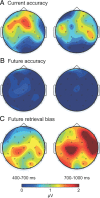Neural correlates of reactivation and retrieval-induced distortion
- PMID: 22933797
- PMCID: PMC3459586
- DOI: 10.1523/JNEUROSCI.1378-12.2012
Neural correlates of reactivation and retrieval-induced distortion
Abstract
Reactivation of recently acquired information can strengthen memory storage and likely contributes to memory consolidation. Retrieval (generating information about prior events) may improve memory storage because it entails reactivation. Alternatively, retrieval may promote storage of retrieved information, and, if retrieval is inaccurate, subsequent recall could be distorted by the retrieved information. If retrieval modifies memory storage, as hypothesized, neural signals associated with accurate retrieval at that time may be distinct from neural signals associated with the degree of repeated retrieval error evident at some later time. We tested this prediction using a 3-session protocol. During session 1, people learned object-location associations to criterion and completed a cued-recall test in which locations were recalled upon viewing objects. During session 2, an electroencephalogram (EEG) was recorded during cued recall for a subset of the associations. During session 3, cued recall was tested for all associations. Retrieval improved storage, in that recall at session 3 was superior for objects tested in session 2 compared with those not tested. Retrieval-induced distortion was revealed in session 3 for those objects tested in session 2, in that those objects were generally placed closer to locations retrieved at session 2 relative to original study locations. EEG analyses revealed positive potentials (400-700 ms) associated with relatively accurate recall at session 2. Memory updating was reflected in positive potentials after 700 ms that differentially predicted the degree to which recall promoted storage of the session-2-retrieved location. These findings demonstrate unique neurocognitive processing whereby memories are updated with information produced during retrieval.
Figures





References
-
- Buckner RL, Wheeler ME, Sheridan MA. Encoding processes during retrieval tasks. J Cogn Neurosci. 2001;13:406–415. - PubMed
-
- Bunsey M, Eichenbaum H. Conservation of hippocampal memory function in rats and humans. Nature. 1996;379:255–257. - PubMed
-
- Butler AC, Marsh EJ, Goode MK, Roediger HL., III When additional multiple-choice lures aid versus hinder later memory. Appl Cogn Psychol. 2006;20:941–956.
Publication types
MeSH terms
Grants and funding
LinkOut - more resources
Full Text Sources
